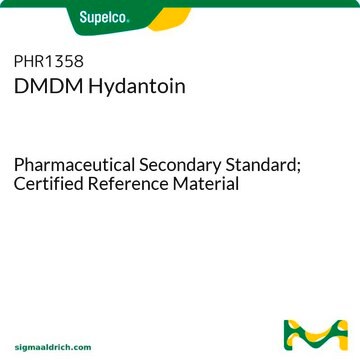D5146
Diazolidinyl urea
≥95%
Synonim(y):
1-[1,3-Bis(hydroxymethyl)-2,5-dioxoimidazolidin-4-yl]-1,3-bis(hydroxymethyl)urea, Diazolidinylurea, N-Hydroxymethyl-N-[1,3-di(hydroxymethyl)-2,5-dioxoimidazolidin-4-yl]-N′-hydroxymethylurea, N-[1,3-Bis(hydroxymethyl)-2,5-dioxo-4-imidazolidinyl]-N,N′-bis(hydroxymethyl)urea
About This Item
Polecane produkty
Próba
≥95%
Postać
powder
temp. przechowywania
2-8°C
ciąg SMILES
OCNC(=O)N(CO)C1N(CO)C(=O)N(CO)C1=O
InChI
1S/C8H14N4O7/c13-1-9-7(18)10(2-14)5-6(17)12(4-16)8(19)11(5)3-15/h5,13-16H,1-4H2,(H,9,18)
Klucz InChI
SOROIESOUPGGFO-UHFFFAOYSA-N
Powiązane kategorie
Opis ogólny
Zastosowanie
- Impact of cosmetic preservatives on skin cells: A study examined the effects of various cosmetic preservatives, including Diazolidinyl Urea, on healthy human skin cells, highlighting the cellular responses and potential implications for skin health (Głaz et al., 2023).
- Formaldehyde releasers in personal care: An extensive clinical review discussed allergic contact dermatitis caused by formaldehyde and formaldehyde releasers such as Diazolidinyl Urea, providing insights into allergic reactions and safety concerns in dermatological practice (Goossens and Aerts, 2022).
- Carcinogenic potential of cosmetic ingredients: Research on potential carcinogens in makeup cosmetics included Diazolidinyl Urea, emphasizing the safety and regulatory aspects concerning its use in cosmetic formulations (Balwierz et al., 2023).
- Patch testing for allergen sensitivity: A study integrated Diazolidinyl Urea in a patch test series to evaluate skin sensitization and allergic reactions in patients, aiding in the assessment of its allergenic potential (Bizjak et al., 2022).
Oświadczenie o zrzeczeniu się odpowiedzialności
Hasło ostrzegawcze
Warning
Zwroty wskazujące rodzaj zagrożenia
Zwroty wskazujące środki ostrożności
Klasyfikacja zagrożeń
Eye Irrit. 2
Kod klasy składowania
11 - Combustible Solids
Klasa zagrożenia wodnego (WGK)
WGK 3
Środki ochrony indywidualnej
dust mask type N95 (US), Eyeshields, Faceshields, Gloves
Certyfikaty analizy (CoA)
Poszukaj Certyfikaty analizy (CoA), wpisując numer partii/serii produktów. Numery serii i partii można znaleźć na etykiecie produktu po słowach „seria” lub „partia”.
Masz już ten produkt?
Dokumenty związane z niedawno zakupionymi produktami zostały zamieszczone w Bibliotece dokumentów.
Klienci oglądali również te produkty
Nasz zespół naukowców ma doświadczenie we wszystkich obszarach badań, w tym w naukach przyrodniczych, materiałoznawstwie, syntezie chemicznej, chromatografii, analityce i wielu innych dziedzinach.
Skontaktuj się z zespołem ds. pomocy technicznej
















